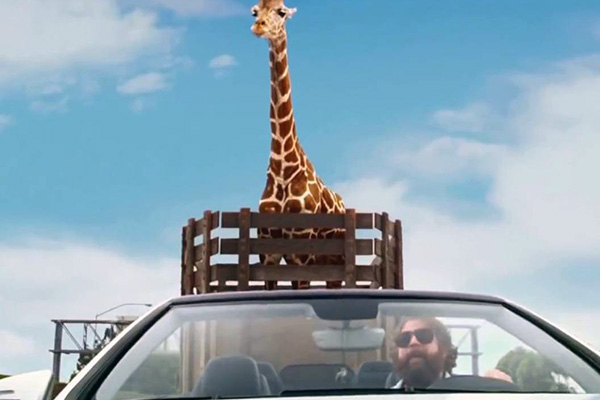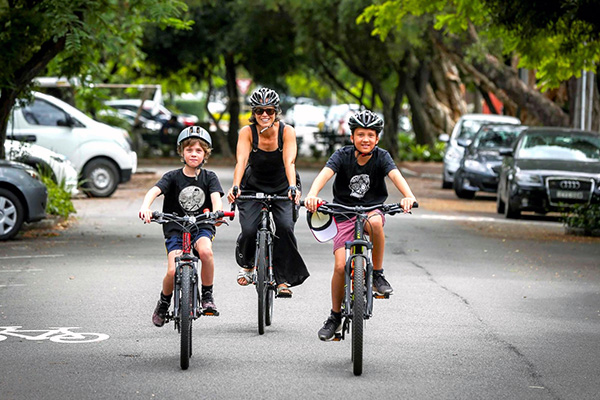Motormonomania. Motor-mono-mania- Say it thrice and swallow. Motormonomania describes the madness that has conditioned us to accept the unacceptable when it comes to cars at the expense of everything else on the planet, planet included.

“My name is Alan and I have a wonderful life!” Zach Galifianakis with Stanley in "The Hangover Part III”
(Image: Warner Bros.)
Great servants but terrible masters
Let’s be clear, cars are great servants. Nearly all of us drive them. They are generally beautifully designed with sleek, comfortable interiors ascribing convenience, personal power, status and individuality. (This is not a car ad) Great servants, with smiley (or frowny pushy) faces, but terrible masters.

Reduced to beggary. This graphic highlights how the majority of traffic 'safety' campaigns focus on everything except the bull in the china shop - the automobile. (Source: Copenhagenize)
70 years of car-centric planning in Australia has resulted in generations of skyrocketing obesity. 25% of Australian children aged 2-17 and 67% of adults are considered overweight or obese. This is linked to inactivity and the fact that most kids no longer walk or ride to school because the roads are regarded as too unsafe for independent mobility. More young people are dying in traffic incidents than from diseases or self-harm. The primary cause of death and disability is speed. But that’s apparently acceptable because 50 or 60 km/h is the legal limit on suburban streets, and if a 5-year-old runs out to pick up her ball and gets hit by a responsible driver, then it’s her fault. Our right to drive at speed on suburban streets and get to where we need to go overrides a child’s right to live. Crazy. Well that’s the law. Let’s explore this madness further because it’s really interesting!
Careening down the rabbit hole
From 1962-1975, 523 Australians died in the Vietnam War. How is this relevant?
In 2022 (just 2022) more than 1160 Australians died on our roads. And the numbers are climbing. Can you guess which of the two national disasters is socially acceptable and which isn’t?

The all-new 2022 Ford Ranger Raptor - feel the exhilaration! (Source: Cars Guide)
If transport policy was determined by facts rather than the politics of vested interests, urban planning would favour vulnerable road users and put pedestrians first. But motormonomania is a heavily-invested emotional state selling glamour and encouraging magical thinking. Here are some leaps of logic from a fascinating British study of 2000 randomised individuals on:
Smoking: 75% of people agreed with the statement: “People shouldn’t smoke in highly populated areas where others have to breathe in the cigarette fumes.” But only 17% agreed when two words were changed to ‘car fumes’.
Theft: Only 37% of people thought the police needed to take action if someone left their “belongings” in the street and they were stolen; with the word changed to “car” it rose to 87%.
Risk: 61% of people agreed that risk was “a natural part of driving”, whereas just 31% agreed when “driving” was changed to “working”.
At Bicycle NSW we regularly have our time wasted by traffic engineers telling us in soporific tones that building extra lanes on a particular motorway will solve traffic congestion. It’s like a smoker stealing time with a triple bypass to continue their risky habit. But this is a collective habit costing everyone and the planet.
Let’s not even get started on the small matter of climate change. In response, Transport for NSW have developed some wonderful active transport and sustainability strategies and policies.
But at the current rate, all these nice policies will take 1000 years to implement.
That’s our conservative estimate. 1000 years. We intend commissioning a study to determine the temporal gap between fine intentions and reality. We’re sure that decision makers and voters across the state will be quite interested in this study. We can collectively moan about legislators being ignorant, feeble, at the behest of vested interests or simply loving their car too much and the perks of being able to park where they please. But that’s not true of everyone. We’ve met great individuals through the course of our advocacy. So what to do?
Our election campaign page enables all of us to stop whining and get active.
Together, let’s find out who is supporting better streets in our electorates and stop backing the dead weights.
The Better Streets coalition will grow throughout the course of the election to directly influence key decision makers. We urge you to join this movement with a proven strategy to affect change at a much faster pace. Because positive action is the best way to dispel magical thinking and bureaucratic inertia.

A better street has limited through traffic, low vehicle speeds and plenty of shade. It is a street where everyone feels safe to walk and cycle (Image: City of Sydney)
Join Bicycle NSW for better infrastructure. And get on board with Better Streets. It’s what we’ve been advocating in NSW for 47 years.

